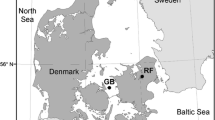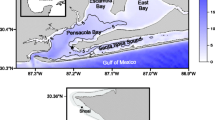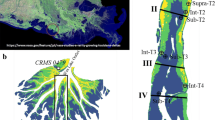Abstract
Bojorquez Lagoon (BL), located on the Mexican Caribbean, has received sewage and dredging impacts as a result of tourism development. The lagoon supports a high diversity of primary producers compared to sheltered adjacent lagoons dominated byThalassia testudinum communities. The Diurnal Curve Method (Odum and Hoskin 1958) was used to measure community metabolism and assess eutrophication in BL by comparing it to the nonimpacted lagoons and to other systems studied with this method. Dissolved oxygen community input to the water column in BL ranged between 8.3 g O2 m−2 d−1 and 41.5 g O2 m−2 d−1 during 1985 and 1986, and averaged 17.1, whereas dissolved oxygen community consumption ranged from 6.4 g O2 m−2 d−1 during 1985 and 1986, and averaged 17.1, whereas dissolved oxygen community consumption ranged from 6.4 g O2 m−2 d−1 to 37.6 g O2 m−2 d−1 and averaged 15.2. These values are higher than those found for the adjacent lagoons and similar coastal lagoons, and are similar to results from other lagoons with sewage or seafood waste discharge. Net flux of oxygen from the community to the water column averaged 1.9 g O2 m−2 d−1 and ranged from −9.8 g O2 m−2 d−1 to 8.1 g O2 m−2 d−1. These values are low compared to the adjacent lagoons, and close to zero, as in dystrophic environments. Primary productivity, as estimated by oxygen input, increased in BL during the period of study, indicating that eutrophication is proceeding, but the lagoon has not reached yet a level of “critical eutrophication” as defined by Mee (1988).
Resumen
La Laguna Bojórquez (LB), ubicada en el Caribe Mexicano, ha sido objeto de impactos por dragados y descargas cloacales, ocasionados por el desarrollo turistico de Cancún. La laguna presenta una gran variedad de productores primarios en comparación con lagunas cercanas en las que domina una comunidad deThalassia testudinum. Se utilizó el método de la curva diurna de oxígeno para medir el metabolismo comunitario (Odum y Hoskin 1958) y evaluar la eutroficación de la LB, comparandola con las lagunas adjacentes y otros sistemas lagunares estudiados con este método. El oxígeno disuelto liberado por la comunidad hacia la columna de agua en LB osciló entre 8.3 g O2 m−2d−1 y 41.5 g O2 m−2 d−1 durante 1985 y 1986, con media de 17.1 g O2 m−2 d−1. El cons comunitario de oxígeno disuelto fue en promedio de 15.2 g O2 m−2 d−1 y osciló de 6.4 O2 m−2d−1 a 37.6 g O2 m−2 d−1. Estos valores son superiores a los encontrados en la laguna adjacente y en otras lagunas similares, pero son parecidos a los observados en lagunas afectadas por descargas diversas. El flujo neto de oxigeno de la comunidad hacia la columna de agua fue en promedio de 1.9 g O2 m−2 m−1 d−1 y varió de −9.8 g O2 m−2d−1 a 8.1 g O2 m−2 d−1, siendo valores inferiores a los encontrados en las lagunas adyacentes y cercanos a cero, como en ambientes distróficos. Laproducción primaria, estimada mediante el oxígeno producido, aumentó en la LB durante el período de estudio, indicando que el proceso de eutroficacion avanza, pero la laguna no ha alcanzado aún el nivel de “Eutroficación Crítica” definido por Mee (1988).
Similar content being viewed by others
Literature Cited
Collado, L., L. Segura, and M. Merino. 1988. Observaciones sobre dos escifomedusas del géneroCassiopea en la Laguna de Bojórquez, Quintana Roo, México.Revista de Investigaciones Marinas, La Habana, Cuba, 21–27.
Copeland, B. J. andT. C. Dorris. 1964. the use of a clear plastic dome to measure gaseous diffusion rate in natural waters.Limnology and Oceanography 9:494–499.
Cory, R. L. 1994. Changes in oxygen and primary production of the Patuxent Estuary, Maryland, 1963 through 1969.Chesapeake Science 15:78–83.
Costa-Moreira, A. L. In Press. Trophic states of Saquarema Lagoon during an annual cycle.In Marine Coastal Eutrophication International Conference. April 21–24, 1990. Bologna, Italy.
Cúlhuac, S. S. 1987. Importancia Ecológica de las Algas Epífitas de las Fanerógamas Marinas en la Laguna Bojórquez, Quintana Roo. Final Report of Social Service. Universidad Autónoma Metropolitana-Iztapalapa, México. 33 p.
Flores, V. F. 1985. Aportes de materia orgánica por los principales productores primarios a un ecosistema lagunar estuarino de boca efímera. Ph. D. Dissertation, Universidad Nacional Autónoma de México, Mexico City. 184 p.
Goldman, C. R. 1988. Primary productivity, nutrients, and transparency during the early onset of eutrophication in ultraoligotrophic Lake Tahoe, California-Nevada.Lymnology and Oceanography 33:1321–1333.
González, L. A. 1989. Hydrología y Nutrientes de la Laguna Bojórquez. M.S.Thesis, Universidad Nacional Autónoma de México. Mexico City. 89 p.
Hartman, R. T. andD. L. Brown 1967. Changes in composition of the internal atmosphere of submerged vascular hydrophytes in relation to photosynthesis.Ecology 48:252–258.
Jordán, D. E., M. Angot, andR. de la Torre. 1978. Prospección biológica de la Laguna Nichupté, Cancún, Quintana Roo, México: Nota científica.Anales del Centro de Ciencias del Mar y Limnología, Universidad Nacional Autónoma de México 5: 179–188.
Jordán, D. E., E. Martin, P. O. Thome, and M. Merino. 1983. Circulación e Hidrología del Sistema Lagunar Nichupté. Universidad Nacional Autónoma de México. Final Report to Fondo Nacional de Fomento al Turismo. México. Mexico City. 72 p.
Kanwisher J 1963. On the exchange of gases between the atmosphere and the sea.Deep Sea Research 10:195–207.
Kemp, W. M. andW. R. Boynton. 1980. Influence of biological and physical processes on dissolved oxygen dynamics in an estuarine system: Implications for measurement of community metabolism.Estuarine and Coastal Marine Science 11: 407–431.
Kester, D. R. 1975. Dissolved gasses other than CO2, p. 497–556In J. P. Riley and G. Skirrow (eds.). Chemical Oceanography, Academic Press, London. Vol. 1, Chap. 8.
Kjerfve, B. 1986. Comparative oceanography of coastal lagoons. p 63–82.In D. Wolfe (ed.), Estuarine Variability. Academic Press, New York.
Margalef, R. 1982. Ecología. Omega, Barcelona. 951 p.
McKellar, H. N., Jr. 1977. Metabolism and model of estuarine bay ecosystem affected by a coastal power plant.Ecological Modelling 3:85–118.
Mee, L. D. 1977. The chemistry and hydrography of some tropical coastal lagoons—Pacific Coast of Mexico. Ph.D. Dissertation. University of Liverpool. England. 125 p.
Mee, L. D. 1988. A definition of “critical eutrophication” in the marine environment.Revista de Biología Tropical 36:159–161.
Merino, M. 1987. The coastal zone of Mexico.Coastal Management 15:27–42.
Merino, M., S. Czitrom, E. Jordán, E. Martin, P. Thome, andO. Moreno. 1990. Hydrology and rain flushing of the Nichupte Lagoon System, Cancun, Mexico.Estuarine, Coastal and Shelf Science 30:223–237.
Merino, M. and M. Gallegos. 1986. Evaluación del Impacto Ambiental Generable sobre el Sistema Lagunar Nichupté por el Dragado Programado Para Rellenar el Lote 18-A en Cancún, Q. Roo. Instituto de Ciencias del Mar y Limnología, Universidad Nacional Autónoma de México. Final Report to PIADISA, ICA. México. 87 p.
Merino, M. andL. Otero. 1990. Atlas Ambiental Costero, Puerto Morelos-Quintana Roo. Centro de Investigaciones de Quintana Roo, México. 89 p.
Nixon, S. W. andC. A. Oviatt. 1972. Preliminary measurements of midsummer metabolism in beds of eelgrass.Zostera marina. Ecology 53:150–153.
Odum, H. T. 1956. Primary production in flowing waters.Limnology and Oceanography 2:85–97.
Odum, H. T. 1963. Productivity measurements in Texas turtle grass and the effects of dredging an intracoastal channel.Publications of the Institute of Marine Science, University of Texas 9:48–58.
Odum, H. T., T. Burkholder, andJ. Rivero. 1959. Measurements of productivity of turtle grass flats, reefs, and the Bahia Fosforecente of Southern Puerto Rico.Publications of the Institute of Marine Science, University of Texas 6:159–170.
Odum, H. T., R. P. Cuzon du Rest, R. J. Beyers, andC. Allbaugh. 1963. Diurnal metabolism, total phosphorus, Ohle anomaly, and zooplankton diversity of abnormal marine ecosystems of Texas.Publications of the Institute of Marine Science, University of Texas 9:404–453.
Odum, H. T. andC. M. Hoskin. 1958. Comparative studies on the metabolism of marine waters.Publications of the Institute of Marine Science, University of Texas 5:16–46.
Odum, H. T. andR. F. Wilson. 1962. Further studies on reaeration and metabolism of Texas bays, 1958–1960.Publications of the Institute of Marine Science, University of Texas 8: 20–55.
Phillips, R. C. andE. G. Meñez. 1987. Seagrasses.Smithronian Contributions to Marine Science 34:1–104.
Reyes, E. 1988. Evaluación de la productividad primaria en la laguna Bojórquez, Cancún, Quintana Roo, México. M.S. Thesis. Universidad Nacional Autónoma de México. Mexico City. 50 p.
SAS Institute Inc. 1987. SAS User’s Guide: Statistics, version 5. SAS Institute, Inc., Cary, NC. 956 p.
Seaton, A. M. andJ. W. Day,Jr. 1983. A trophic state index for the Louisiana coastal zone. Coastal Ecology Laboratory, Center for Wetland Resources, Louisiana State University, Baton Rouge. Final Report to the Louisiana Water Resource Research Institute. Baton Rouge, Louisiana. 50 p.
Serviere, Z. E. 1986. Ficoflora de la Laguna de Bojórquez, Quintana Roo. B.S. Thesis. Universidad Nacional Autónoma de México. Mexico City. 253 p.
Strickland, J. D. H. and T. R. Parsons. 1972. A Practical Handbook of Seawater Analysis. Bulletin 167. Fisheries Research Board of Canada. 306 p.
Thayer, G. W., D. A. Wolfe, andR. B. Williams 1975. The impact of man on seagrass systems.American Scientist 63:288–296.
Tissen, S. B. andA. Eijgenraam. 1982. Primary and community production in the Southern Bight of the North Sea deduced from oxygen concentrations variation in the spring of 1980.Netherlands Journal of Sea Research 16:247–259.
Vollenweider, R. A. In Press. Coastal marine eutrophication.In Marine Coastal Eutrophication International Conference. April 21–24, 1990. Bologna, Italy.
Zieman, J. C. andR. G. Wetzel 1980. Productivity in seagrasses: Methods and rates, p. 86–116.In R. C. Phillips and C. P. McRoy (eds.) Handbook of Seagrass Biology: An Ecosystem Perspective. Garland STPM Press, New York.
Author information
Authors and Affiliations
Rights and permissions
About this article
Cite this article
Reyes, E., Merino, M. Diel dissolved oxygen dynamics and eutrophication in a shallow, well-mixed tropical lagoon (Cancun, Mexico). Estuaries 14, 372–381 (1991). https://doi.org/10.2307/1352262
Received:
Accepted:
Issue Date:
DOI: https://doi.org/10.2307/1352262




